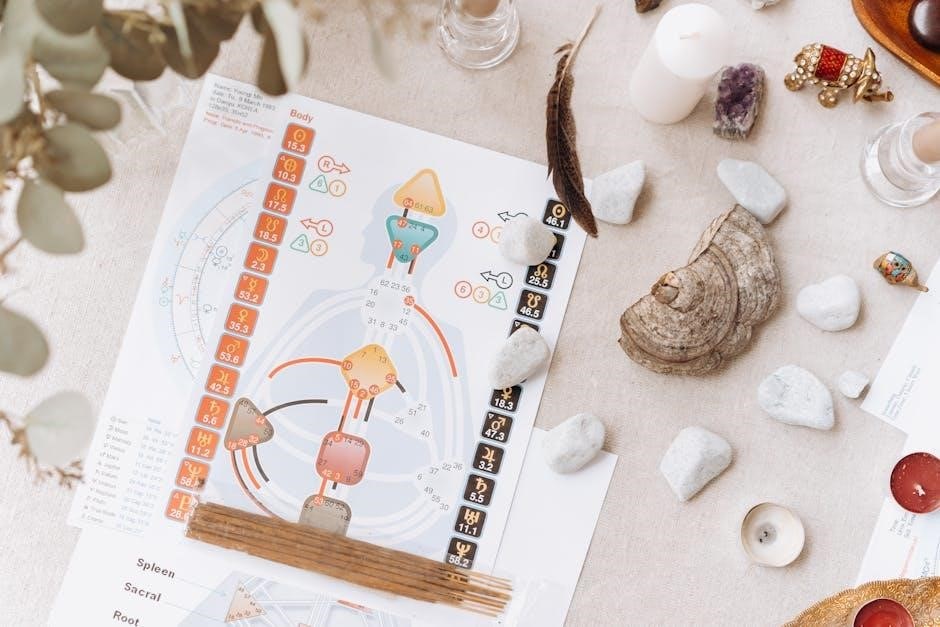Bead sizes are crucial in jewelry making and crafts. They are typically measured in millimeters (mm)‚ but seed beads use a unique “aught” system. Understanding these measurements is essential for accurate project planning.
The “aught” system‚ denoted as “#/0” (e.g.‚ 6/0)‚ refers to the approximate number of beads per inch. A larger number indicates smaller beads. This system can be confusing‚ but charts help clarify sizes.
Accurately measuring bead sizes is fundamental in jewelry making and various craft projects. Beads are commonly measured in millimeters (mm)‚ which represents the distance between the bead holes. However‚ seed beads utilize a distinct “aught” system that can initially seem perplexing. This system is based on the approximate number of beads that can fit within one inch. Understanding both measurement systems is crucial for selecting the correct beads for a specific project and achieving the desired aesthetic.
Knowing the precise bead size allows for accurate estimations of material quantities needed for a design. It also ensures that beads will properly fit with other components‚ such as wires‚ cords‚ and findings. Bead size charts serve as invaluable tools for comparing different bead sizes and converting between millimeters and the aught system. They help in visualizing the actual size of a bead‚ especially when ordering online‚ where images can sometimes be misleading. Properly using bead size charts enhances precision and reduces errors in beadwork.

Understanding Bead Sizes
The “Aught” System for Seed Beads
The “aught” system‚ often written as “#/0” (e.g.‚ 11/0)‚ is a unique sizing method used specifically for seed beads. Unlike millimeter measurements‚ the aught number indicates the approximate number of beads that would fit within one inch. A larger aught number signifies smaller beads; for instance‚ size 11/0 beads are smaller than size 6/0 beads. This system can be initially confusing‚ as it is an inverse relationship.
The exact size in millimeters can vary slightly between different brands and even different finishes within the same brand. Czech seed beads‚ for example‚ may not conform precisely to the standard aught size. Therefore‚ relying solely on the aught number without referring to a bead size chart can lead to inaccuracies. Printable PDF bead size charts that include both aught sizes and millimeter equivalents are invaluable tools. These charts allow for visual comparison and more precise bead selection‚ especially when matching beads from different manufacturers or finishes.

Bead Size Charts and Guides
Printable Bead Size Chart (PDF)
Bead size charts and guides are essential tools for jewelry makers. Printable PDF charts offer a convenient reference for accurate bead size comparison‚ aiding in project planning.
Printable Bead Size Chart (PDF)
A printable bead size chart in PDF format is an invaluable resource for jewelry designers and beaders. These charts typically display standard bead sizes‚ including both round and oval beads‚ and can even be applied to cabochons. For accuracy‚ it’s crucial to print the chart at 100% size on A4 paper (21cm x 29.7cm). This ensures that the measurements on the chart correspond accurately to the actual bead sizes.
These charts often include millimeter measurements‚ as well as the “aught” system used for seed beads‚ making it easy to compare different types of beads. Many online resources offer downloadable PDF bead size charts that you can print for personal or educational use. Some charts also include information on bead hole sizes‚ which is essential for selecting the correct wire or thread for your project.
Having a printable bead size chart handy allows you to quickly identify bead sizes‚ estimate the number of beads per inch or strand‚ and ensure that your designs are accurate and consistent. Always verify the chart’s accuracy by measuring a known bead size against the printed chart.
Importance of Printing at 100% Size
When using a printable bead size chart‚ it is paramount to ensure that you print it at 100% size‚ without any scaling or resizing. This ensures the accuracy of the chart and its ability to provide a reliable reference for bead sizes. Printing at any other scale can distort the measurements‚ leading to incorrect estimations and potentially flawed jewelry designs.
Most printers have a default setting that might “shrink to fit” or “scale to fit” the page. This setting automatically adjusts the size of the image to fit within the printable area‚ which can significantly alter the dimensions of the bead sizes on the chart. To prevent this‚ carefully check your printer settings before printing. Look for options like “actual size‚” “no scaling‚” or “100%.” Select the appropriate option to ensure that the chart is printed without any alterations.
Verifying the printed chart with a ruler or a bead of a known size is also a good practice. This confirms that the printed dimensions match the actual sizes. Remember‚ accuracy is key when working with bead sizes‚ especially for intricate designs that require precise measurements.
Bead Size Chart for Hooks and Cones
Selecting the correct bead or cone size to match a hook is crucial in various crafts‚ particularly in jewelry making and fly fishing. A bead size chart specifically designed for hooks and cones provides a convenient reference for matching these components accurately. Remembering the correlation between hook sizes‚ bead sizes‚ and cone sizes can be challenging‚ making such a chart an invaluable tool.
These charts typically list hook sizes alongside corresponding bead and cone dimensions‚ often in both inches and millimeters. This dual measurement system accommodates different preferences and ensures compatibility across various projects. For example‚ the chart might indicate that a size 10 hook pairs well with a 3mm bead or a small cone. Some charts also include information on countersunk beads‚ also known as cyclops beads‚ which have a specific shape designed to fit snugly around a hook.
Having a readily available bead size chart for hooks and cones streamlines the selection process‚ reduces errors‚ and ultimately enhances the quality of the finished product. It’s a practical resource for both beginners and experienced crafters.
Specific Bead Types and Sizes
Seed bead sizes are indicated by a number (e.g.‚ 11/0)‚ where a larger number means a smaller bead. This system differs from millimeter measurements and can be confusing without a reference chart.
Seed Bead Sizes Explained
Seed bead sizing can be perplexing‚ as it doesn’t follow typical millimeter measurements. Instead‚ seed beads are labeled with a number‚ often written as 11/0 or similar‚ which indicates their size. This number refers to the approximate number of beads per inch‚ but it’s not always exact.
The higher the number‚ the smaller the bead. For instance‚ a size 15/0 seed bead is significantly smaller than a size 6/0 seed bead. This inverse relationship can be initially counterintuitive‚ leading to confusion when selecting the appropriate size for a project.
Different manufacturers may also have slight variations in size‚ so a size 11/0 from one brand might not be precisely the same as a size 11/0 from another. Czech seed beads‚ in particular‚ may not conform perfectly to the “aught” size due to manufacturing variations. Therefore‚ it’s always best to refer to a bead size chart and consider the specific brand when accuracy is crucial.
Using a printable bead size chart‚ ideally printed at 100% scale‚ can help visualize these subtle differences and ensure you choose the correct seed bead size for your needs.
Miyuki Bead Sizes and Finishes
Miyuki beads are renowned for their consistent size and shape‚ making them a favorite among bead artists. Miyuki offers a wide variety of seed bead sizes‚ each labeled with a number that corresponds to its size‚ similar to the standard seed bead sizing system.
Understanding Miyuki bead sizes is essential for creating intricate beadwork designs. They offer Delica beads‚ known for their cylindrical shape and exceptional uniformity‚ as well as round seed beads in various sizes‚ such as 11/0 and 15/0. Each size has specific applications‚ from delicate embroidery to structural bead weaving.
In addition to their precise sizing‚ Miyuki beads come in an extensive range of finishes. These finishes can significantly impact the bead’s appearance‚ from shimmering metallic coatings to matte and luster effects. The finish affects not only the color but also the bead’s texture and light reflection.
To accurately assess Miyuki bead sizes and finishes‚ it’s helpful to consult Miyuki’s sample cards and size charts. These resources provide detailed information about each bead type‚ size‚ and available finishes‚ ensuring you select the perfect Miyuki beads for your creative projects. Printable PDF charts are invaluable for reference.
Czech Seed Bead Variations
Czech seed beads‚ celebrated for their rich history and diverse range of colors and finishes‚ also exhibit variations in size and shape. Unlike Miyuki beads‚ which are known for their uniformity‚ Czech seed beads often present slight inconsistencies‚ adding a unique charm to beadwork projects.
These variations stem from the traditional manufacturing processes used in their production. Czech seed beads come in sizes ranging from tiny 15/0 to larger 6/0‚ each with slight differences in diameter and hole size. The “aught” system is used‚ but actual sizes can deviate‚ so charts are essential.
Moreover‚ Czech seed beads are available in numerous shapes‚ including round‚ rocailles‚ charlottes (faceted)‚ and bugles. Each shape interacts differently with light and adds texture to designs. Variations in shape and size can affect bead counts per inch or strand.
When working with Czech seed beads‚ it’s crucial to embrace their individuality. Using a bead size chart can help estimate dimensions‚ but precise measurements may vary. It is advisable to purchase slightly more beads than needed to account for any inconsistencies. Embracing these variations can enhance the organic‚ handcrafted feel of your beadwork.

Using Bead Size Charts
Bead size charts are invaluable for accurately determining bead dimensions. They assist in selecting the right beads for projects‚ calculating quantities‚ and ensuring compatibility with patterns and designs. These charts provide a visual reference.
Measuring Beads with Household Objects
Even without precise measuring tools‚ you can estimate bead sizes using common household objects. A ruler marked in millimeters is helpful for direct comparison. Coins‚ for instance‚ have known diameters and can serve as a reference. Place the bead next to the ruler or coin to gauge its approximate size. This method is particularly useful when a detailed bead size chart isn’t immediately available.
Another technique involves comparing the bead to the width of a standard paperclip or the diameter of a pencil lead. These objects provide a rough estimate‚ aiding in identifying beads that are roughly 2mm‚ 3mm‚ or larger. This is beneficial for matching beads to existing components or determining their suitability for specific jewelry-making techniques. However‚ remember that household object comparisons offer only approximations.
For more accurate results‚ especially when precision is crucial‚ it’s best to use a printed bead size chart. Ensure the chart is printed at 100% scale to maintain its accuracy. Then‚ physically place the bead onto the chart to find its closest matching size. This approach is far more reliable than relying solely on household objects.
Calculating Beads Per Inch/Strand
Determining the number of beads needed for a project involves calculating beads per inch or beads per strand. A bead size chart is invaluable for this. Once you know the bead’s size in millimeters‚ you can estimate how many will fit within an inch. For example‚ smaller beads‚ like size 11/0 seed beads (approximately 2mm)‚ will yield more beads per inch compared to larger 6mm beads.
To calculate beads per inch‚ divide 25.4 (the number of millimeters in an inch) by the bead’s millimeter size. This provides an approximate count. However‚ variations in bead shape and stringing tightness can affect the actual number. When planning a strand‚ measure the desired length in inches and multiply by the beads per inch calculation.
Consider purchasing slightly more beads than calculated to account for potential breakage or size inconsistencies. Many bead suppliers offer “beads per strand” charts that provide estimates for common bead sizes. These charts streamline the planning process and ensure you have adequate materials for your jewelry or craft project. For greatest accuracy‚ always double-check with a ruler.

Resources for Bead Information
Numerous online resources provide comprehensive information on bead sizes‚ hole sizes‚ and conversions. Websites‚ forums‚ and online stores often offer charts and guides to assist with bead selection and project planning.
Online Resources for Bead Sizes and Hole Sizes
Finding accurate bead size and hole size information can be streamlined with various online resources. Many jewelry-making websites‚ bead suppliers‚ and crafting forums offer detailed charts and guides. These resources often include printable bead size charts in PDF format for convenient reference.
Websites dedicated to bead information often feature comprehensive databases of bead sizes‚ including conversions between millimeters and the “aught” system used for seed beads. Some sites provide visual comparisons of different bead sizes‚ aiding in the selection process.
Online forums and communities can also offer valuable insights. Experienced beaders frequently share tips‚ tricks‚ and personal experiences related to bead sizing. They may also provide links to helpful charts or recommend specific resources.
When using online resources‚ it’s crucial to verify the accuracy of the information. Cross-referencing data from multiple sources can help ensure that the bead sizes and hole sizes are correctly represented. Always check user reviews and feedback regarding any online bead suppliers.
Many resources also include tutorials on measuring beads and calculating beads per inch or strand. These resources can be helpful for project planning and bead estimation. Be aware that actual bead sizes may vary from brand to brand.
Where to Find Printable Charts
Printable bead size charts are readily available from various online sources. Many jewelry-making websites‚ bead suppliers‚ and crafting blogs offer these charts as a free resource. These charts are often in PDF format‚ making them easy to download and print for convenient reference.
Reputable bead retailers frequently provide bead size charts on their websites to assist customers in selecting the correct bead sizes for their projects. These charts may include standard sizes for round and oval beads‚ as well as specific charts for seed beads‚ crystals‚ and cabochons.
Crafting blogs and DIY websites often feature printable bead size charts as part of tutorials or informational articles. These charts may be tailored to specific types of beads or projects. Educational websites that teach jewelry making‚ are also a good place to find the charts.
When searching for printable charts‚ look for reputable sources that provide accurate and reliable information. Check that the chart includes the bead sizes you need and that it is clearly labeled with the correct units of measurement. Ensure the PDF is printable at 100% size.
Before printing‚ always preview the chart to ensure that it will print correctly on your paper size. Remember always to credit the source from which you got the chart.
